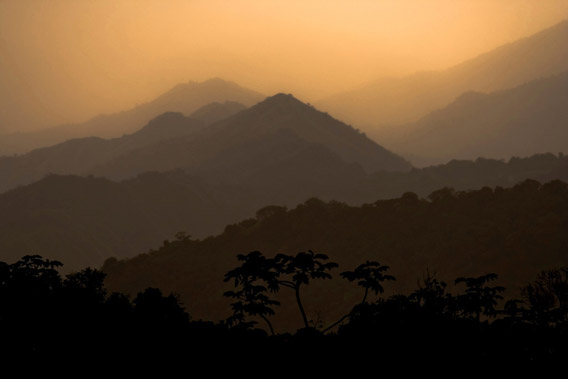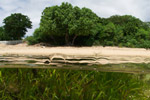
Sunset over the Sierra Nevada de Santa Marta in Colombia. This site is the last remaining refuge of 13 highly threatened species, but also provides many benefits to people. For example, the river basins are a very important source of clean freshwater to downstream human populations, and the tropical rainforest store a significant amount of carbon important for climate change mitigation. The site also has considerable cultural value as about 30,000 indigenous people of four ethnic groups are living in the area and consider it sacred. Photo © Robin Moore/iLCP.
Preventing the extinction of the world’s most imperiled species would also bring untold benefits to people according to new research in the open-access journal PLoS ONE. Looking at the world’s nearly 600 Alliance for Zero Extinction (AZE) sites, the study found that preserving these ecosystems would benefit humans even beyond preserving biodiversity, including safeguarding freshwater, carbon storage, and protecting cultural diversity. AZE sites are identified as habitats containing one or more species listed as Endangered or Critically Endangered by the IUCN Red List, in which the survival of the species is highly dependent on the conservation of the ecosystem in question.
“Since world leaders have agreed to increase the current global coverage of protected areas from 13 percent to 17 percent of Earth’s land by 2020, it is essential that this expansion of protected areas focus on the unprotected AZE sites,” explained co-author Frank Larsen with Conservation International. “It is encouraging that protecting the AZE sites will not only prevent imminent species extinctions but also increase the benefits of ecosystem services for people.”
The study, which compared the ecosystem services of AZE sites to randomly selected sites in a country or ecoregion, found that AZE sites on average stored three times more carbon than random sites due to the higher presence of carbon-rich ecosystems such as forests. Water quality in high priority conservation sites was 1.3 times higher than random sites as well, with a significantly more AZE sites providing clean water downstream to local communities since many AZE sites are found in mountainous areas with high precipitation. Protecting AZE sites would also help maintain global cultural diversity: the study found that AZE site contained 1,063 different languages, while randomly selected sites only contained 672 languages.
Still, many of the world’s AZE sites remain unprotected. A recent analysis, also in PLoS ONE, found that 51 percent of the world’s AZE sites lack protection, leaving 414 Endangered and Critically Endangered species without the basic habitat protection needed to stave off extinction.
“These critical conservation sites, essential for halting imminent species extinctions, are also effective choices for delivery of ecosystem services for human well-being,” said co-author Will Turner, Vice President of Conservation Priorities and Outreach at CI. “If we don’t conserve these AZE sites, we will not only witness species extinctions, but we will witness a significant loss of the benefits that people derive from nature.”

Blunt-headed green treesnake (Uromacer catesbyi) in the Massif de la Hotte, Haiti.The Massif de La Hotte mountainous regions are the last remnants of Haiti’s cloud forest that support unique species. The region has more critically endangered species than anywhere else in the world, including 13 AZE trigger species. It is under extreme population pressures including slash and burn agriculture and extraction of timber as well as non timber products. The Alliance for Zero Extinction (AZE) has ranked this the third most important priority area for conservation because of its rich biodiversity and high levels of endemism. Photo by: © Robin Moore.
Related articles
Over 5,000 vital biodiversity sites remain unprotected
(03/22/2012) A recent study has found that half of the world’s Important Bird Areas (IBAs) and Alliance for Zero Extinction (AZE) sites remain unprotected, leaving many endangered species, some on the verge of extinction, gravely vulnerable to habitat loss. Published in the open access journal PLoS ONE, the study urges governments to focus on expanding protected areas to cover the species that need it most.
Seagrass beds store 20 billion tons of carbon

(05/22/2012) Just below the ocean’s surface lies a carbon powerhouse: seagrass meadows. New research in Nature Geoscience estimates that the world’s seagrass meadows conservatively store 19.9 billion metric tons of carbon, even though the threatened marine ecosystems make up only 0.2 percent of Earth’s surface. The findings lend support to the idea that seagrass protection and restoration could play a major role in mitigating climate change.
Consumption, population, and declining Earth: wake-up call for Rio+20

(05/15/2012) Currently, human society is consuming natural resources as if there were one-and-a-half Earths, and not just a single blue planet, according to the most recent Living Planet Report released today. If governments and societies continue with ‘business-as-usual’ practices, we could be consuming three years of natural resources in 12 months by 2050. Already, this ecological debt is decimating wildlife populations worldwide, disproportionately hurting the world’s poor and most vulnerable, threatening imperative resources like food and water, heating up the atmosphere, and risking global well-being.
Can loggers be conservationists?

(05/10/2012) Last year researchers took the first ever publicly-released video of an African golden cat (Profelis aurata) in a Gabon rainforest. This beautiful, but elusive, feline was filmed sitting docilely for the camera and chasing a bat. The least-known of Africa’s wild cat species, the African golden cat has been difficult to study because it makes its home deep in the Congo rainforest. However, researchers didn’t capture the cat on video in an untrammeled, pristine forest, but in a well-managed logging concession by Precious Woods Inc., where scientist’s cameras also photographed gorillas, elephants, leopards, and duikers.
Biodiversity loss cripples plant growth

(05/02/2012) For decades scientists have been warning that if global society continues with “business-as-usual” practices the result will be a mass extinction of the world’s species, an extinction event some researchers say is already underway. However, the direct impacts of global biodiversity loss has been more difficult to compile. Now a new study in Nature finds that loss of plant biodiversity could cripple overall plant growth.